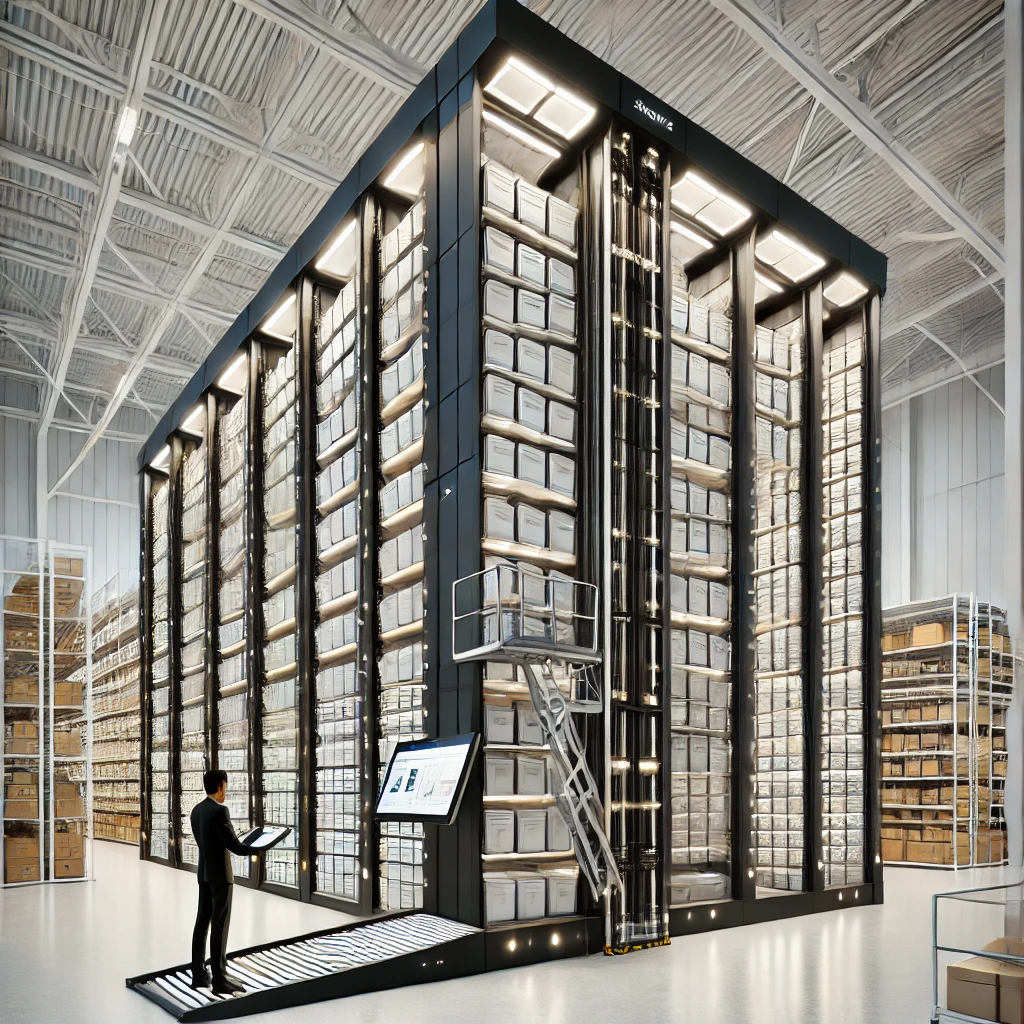What is Vertical Automatic Storage System?
A Vertical Automatic Storage System (VASS) is a space-saving, high-density material handling system designed to automate the storage and retrieval of items, typically in manufacturing, logistics, or warehouse settings. This system is often used to store a wide variety of items, from small parts to large pallets, in an efficient and organized manner. Here’s a technical breakdown of how it works and its components:
1. Basic Structure
- Vertical Storage Columns: The system consists of two main vertical columns or towers where goods or containers (such as trays, bins, or pallets) are stored.
- Carrier/Extractor Mechanism: A motorized platform or extractor moves vertically between the columns to retrieve or store the goods. It automatically transports the requested item to the operator’s position.
2. Storage Shelves/Trays
- The system features modular trays or shelves that can be adjusted based on the height of the items being stored.
- Items are stored in these trays within the vertical columns, making optimal use of vertical space.
3. Retrieval Mechanism
- Automated Lifts: VASS uses automated lifts to move vertically, allowing quick access to items in high or low locations.
- Computer-Controlled: The system is often computer-controlled, enabling precise and fast retrieval. Users input a command via a control panel, and the system retrieves the item automatically.
4. Automation and Control
- Software Integration: These systems are typically connected to warehouse management software (WMS) or enterprise resource planning (ERP) systems. This integration allows real-time inventory management and automation of storage and retrieval processes.
- Inventory Tracking: VASS is equipped with barcodes, RFID tags, or sensors to track the location and movement of items, ensuring accurate stock control.
- User Interface: The operator interacts with the system through a human-machine interface (HMI) or touchscreen, selecting the desired item or storage location.
5. Space Optimization
- Compact Footprint: One of the main advantages of a vertical storage system is the space-saving design. Instead of spreading storage horizontally, it utilizes unused vertical space, often up to 20 meters or more in height.
- High-Density Storage: Items are stacked vertically and closely packed, increasing storage capacity in a smaller floor space.
6. Efficiency and Speed
- Reduced Retrieval Time: Automated retrieval systems can significantly reduce the time it takes to find and pick items compared to manual storage systems. This is particularly valuable in industries where time is a critical factor, such as manufacturing and logistics.
- Ergonomic Access: The system delivers items directly to the operator at an ergonomically optimal height, eliminating the need for employees to bend, reach, or climb ladders.
7. Safety Features
- Safety Sensors: These systems come with built-in safety sensors to prevent collisions or errors during the retrieval process.
- Automated Doors: Some systems include automated doors that open only when the tray reaches the retrieval point, enhancing safety and security.
- Load Balancing: Sophisticated systems monitor the weight distribution of stored items to prevent overloading of trays or the system itself.
8. Types of Vertical Automatic Storage Systems
- Vertical Lift Module (VLM): This consists of two columns of trays with a central extractor that moves up and down between them, picking and placing trays as required.
- Vertical Carousel: A series of rotating shelves or trays that move in a loop (like a Ferris wheel). This system brings the required tray to the operator’s level automatically.
9. Use Cases and Applications
- Manufacturing: For storing tools, spare parts, and production components that need to be accessed quickly and efficiently.
- Warehousing: Used in distribution centers to store inventory or stock items in a compact manner.
- Pharmaceutical: Storing medicines and medical supplies in a safe, temperature-controlled, and organized way.
- E-commerce and Retail: High-frequency picking environments where fast access to products is critical.
10. Advantages
- Maximizes Space Utilization: Takes advantage of vertical space, reducing the footprint required for storage.
- Improves Picking Efficiency: Speeds up the picking process, reducing human error and retrieval times.
- Enhances Safety: Minimizes risks related to manual handling, such as reaching, bending, and climbing.
- Optimized Inventory Management: Integrated systems keep track of stock levels in real-time, improving inventory control.
11. Disadvantages
- High Initial Investment: VASS can be expensive to purchase and install, particularly for smaller businesses.
- Maintenance Requirements: Like any automated system, it requires regular maintenance to ensure smooth operation.
- Not Suitable for All Item Sizes: May not be suitable for items that are too large or irregularly shaped for tray-based storage.
Conclusion:
A Vertical Automatic Storage System offers numerous technical advantages for organizations looking to optimize space and automate the retrieval and storage process. It enhances efficiency, improves ergonomics, and integrates seamlessly with inventory management systems, making it a vital tool for modern manufacturing, logistics, and warehousing operations.


